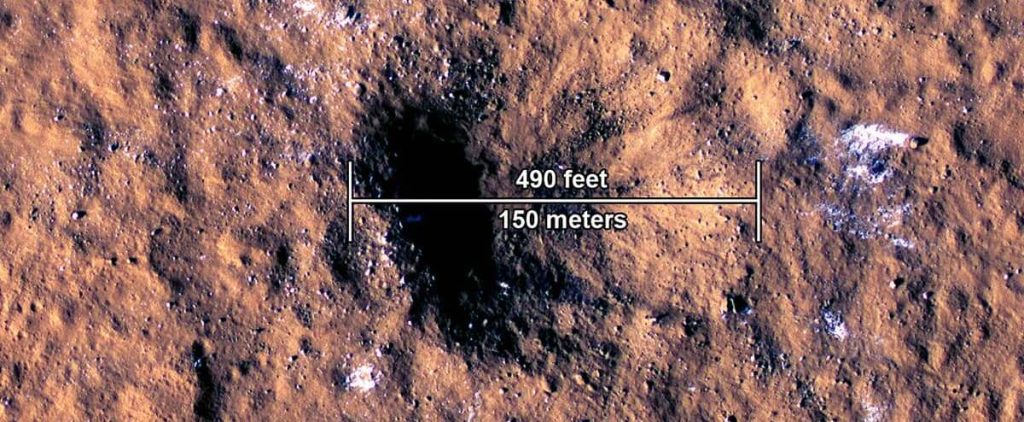Scientists observing Mars received a wonderful Christmas gift last year.
• Read also: Mars ‘Not Too Dead’
On December 24, 2021, a meteor hit its surface, causing 4 earthquakes.
These were discovered by the Insight probe and its seismometer, which landed on Mars nearly four years ago, about 3,500 kilometers from the impact site.
But the origin of this Martian earthquake was only confirmed later by a spacecraft called the Mars Reconnaissance Orbiter (MRO). Orbiting the planet, it took pictures of the newly formed crater within 24 hours of the event.
The picture is impressive: blocks of ice were thrown to the surface, and a crater about 150 meters in diameter and 20 meters deep – the largest crater ever observed since the launch of the MRO orbiter, was drilled 16 years ago.
Although meteor impacts on Mars are not uncommon, “we never thought we’d see something of this magnitude,” Ingrid Daubar, who works on the Insight and MRO missions, said at a press conference Thursday.
The researchers estimate that the meteorite itself should have been about 12 meters away – which on Earth would have caused it to disintegrate in the atmosphere.
Philip Lugnoni, a professor of planetary science who co-authored two of the studies, explained these observations, published Thursday in the journal Science.
NASA has released an audio recording of the earthquake, obtained by accelerating the vibrations collected by a seismometer to make them audible.
Useful ice cream
The valuable information collected should help improve the inner knowledge of Mars and its formation history.
The presence of ice, in particular, is “surprising,” said Ingrid Dubar, who co-authored the two studies. “It’s the hottest spot on Mars, and it’s closest to the equator, where we’ve seen ice.”
In addition to the discovery’s scientific interest in studying the climate of Mars, the presence of water at this latitude could be “very useful” for future explorers, said Laurie Glaese, NASA’s director of planetary sciences.
“We would like the astronauts to land as close to the equator as possible,” she said, due to the warming. However, the ice on site can then be converted to water or oxygen.
The impact of the meteorite was strong enough to generate body waves (spread to the core) and surface waves (passing the planet’s crust horizontally) – which made it possible to study the internal structure of Mars in detail.
Thus, it was found that the crust on which InSight is located is less dense than the one that was traversed from the impact site.
In addition, existing models “on the deep structure of Mars’ mantle deserve a little re-analysis” in light of these data, explained Philippe Lugnoni, of the Institute of Geophysics in Paris (IPGP).
As expected, the Insight probe is now running in slow motion due to the dust accumulating on its solar panels. It’s likely that communication will be lost in “about four to eight weeks,” Bruce Banerdt of NASA’s Jet Propulsion Laboratory said Thursday, who said he was “sad” but welcomed the success of the mission.
Insight has detected more than 1,300 “earthquakes” in all – including some caused by smaller meteorites – and scientists around the world will use the data collected for years to come.

“Hardcore beer fanatic. Falls down a lot. Professional coffee fan. Music ninja.”







More Stories
Ocean looks from the heart in a film discussion
The terrifying story behind the giant heart visible on Pluto's surface
[VIDÉO] Cam DS reveals its best titles around the world